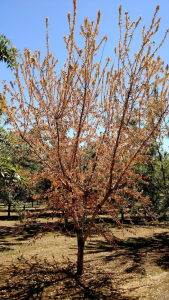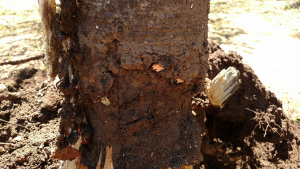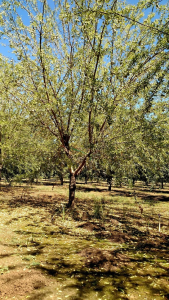This 4th leaf almond orchard had multiple trees collapse suddenly when temperatures warmed up. In some cases, the trees were isolated and surrounded by apparently healthy trees; in others, several trees down the row died almost simultaneously.

This almond tree collapsed suddenly when temperatures rose above 100 degrees.
Because the trees collapsed so quickly and there was no evidence of suckering (not all almond rootstocks sucker, but Krymsk 86, the rootstock here, typically does), I suspected that the problem was down in the crown or roots. We pulled out a tree and the cause was instantly obvious:

The bark and conductive tissue has been removed around the crown of this tree, effectively girdling it.
Gopher(s) had chewed around the crown of the tree just below the soil line, perhaps when their primary food source (weeds) were killed. Removal of the conductive tissue around the crown inhibits water and nutrient uptake, and if the damage is extensive enough, the tree is girdled. The row of trees that was dead had the same issue, as well as some tell-tale signs of gopher presence.

Note the trail of gopher mounds leading to this almond tree with a thinning canopy.
Gopher control is a year-round job and the damage can be extensive if the populations get away from you. We’ve posted several articles dealing with gopher control:
Pocket Gopher Management
Step by Step Gopher Control
Options for Gopher Management
Pocket Gopher and Ground Squirrel Management


Leave a Reply